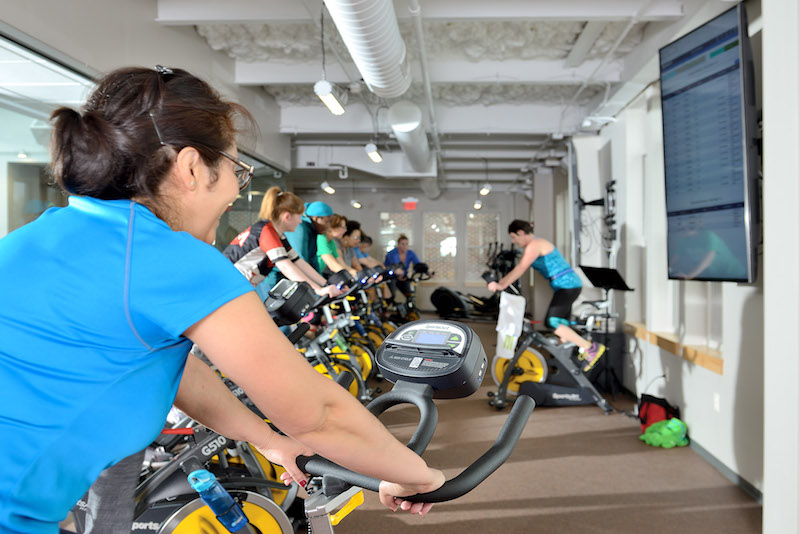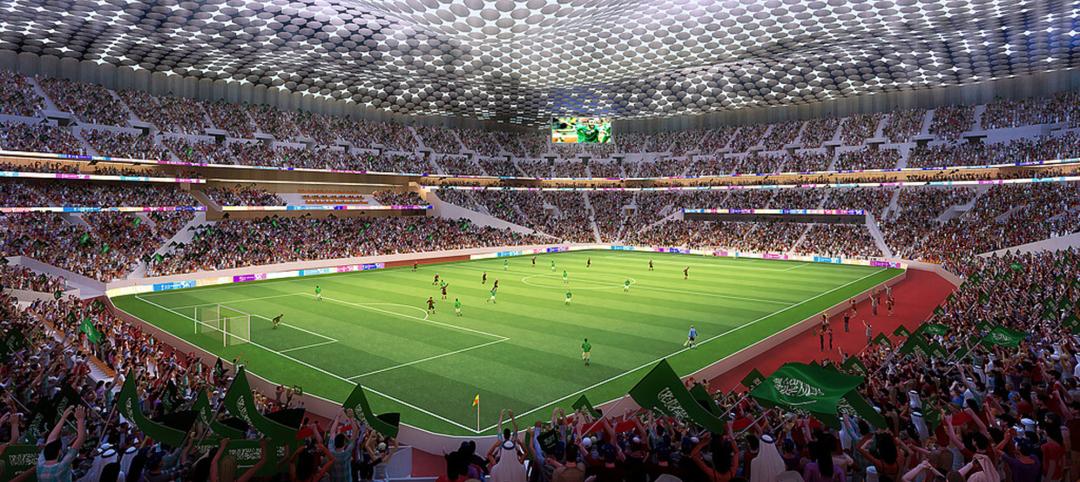Every day, in gyms across America, people of all ages and shapes exercise on treadmills, bicycles, steppers, and elliptical machines that provide their users with digital readouts of how fast they are going and how many calories they are burning.
And now, a new 1,300-sf gym that’s part of The Market at I-Square, a mixed-use development in Rochester, N.Y., is using the energy generated by members on its 17 spin bikes, two recumbent bikes, and two ellipticals as one of the sources powering The Imaginarium, a two-story, 9,000-sf Net Zero Energy arts-and-sciences center within the development that showcases earth-friendly practices, and includes the ECO Gym on its second floor, a rooftop kitchen and bar, a vertical garden, and a virtual-reality lounge.
ECO gym, which opened a few weeks ago, is expected to generate 3,660 kWhs of electricity annually, or about 5% of the Imaginarium’s annual demand. The Imaginarium gets another 35% of its power from small wind turbines with a power rating of 8.9 kWs. Other renewable energy sources for this center include 92 solar panels, and a geothermal heating and cooling system.
The exercise machines were provided by SportsArt America, whose U.S. headquarters is in Mukilteo, Wash. SportsArt started producing fitness equipment in 1977 and launched its ECO line in 2014.
Each piece of equipment has an interface where users can track their “human watts” (the amount of electricity a user is generating by using the equipment) and compare these to the amount of electricity the equipment returns to the grid. The company estimates that about 74% of the energy generated during a workout on its equipment is captured for use to power the building.

The gym's equipment lets users track their “human watts” against the amount of eletricity returned to the grid. The equipment captures about 74% of what's generated for the building's energy consumption. Image: SportsArt
Until recently, SportsArt—which does business in over 70 countries and has offices in the U.K., Switzerland, Taiwan, and Beijing—has placed its equipment mostly in gyms and hotels in Europe and Asia. It is now eyeing North America for growth.
The first U.S. gym to take on the company’s ECO-POWR cardio line of spinning bikes was Sacramento (Calif.) Eco Fitness, which opened in December 2016. At the time of that opening, SportsArt America estimated that a single hour-long workout would produce more than 160 watts per hour per unit of electricity.
Ivo Grossi, its CEO, says SportsArt America’s main target markets for expansion in the U.S. are independent health clubs and studios; colleges and universities; hotels, and multi-housing and residential projects. (On its website, SportsArt America has a room-planning page that allows homeowners to digitally place its equipment in different residential room configurations.)
“We look forward to bringing sustainability to the forefront of the fitness industry. We aspire to be the Tesla of fitness, which is a vision in line with the wants of the largest demographic group flocking to the fitness industry: The Millennials,” says Grossi.
I-Square and SportsArt America were involved in the interior design of ECO Gym in Rochester, whose Building Team included Meehan Architecture (architect), LeFrois Builders & Developers (GC), CM Armitage Electrical Contracting (EE), Kenron Industrial Air Conditioning (HVAC), and Green Leaf Professional Services (IT).
Related Stories
Architects | Jun 6, 2023
Taking storytelling to a new level in building design, with Gensler's Bob Weis and Andy Cohen
Bob Weis, formerly the head of Disney Imagineering, was recently hired by Gensler as its Global Immersive Experience Design Leader. He joins the firm's co-CEO Andy Cohen to discuss how Gensler will focus on storytelling to connect people to its projects.
Sports and Recreational Facilities | May 30, 2023
How design supports a more holistic approach to training
For today’s college athletes, training is no longer about cramming team practices and weight lifting sessions in between classes.
Arenas | May 18, 2023
How can we reimagine live sports experiences?
A Gensler survey finds what sports fans' experiences have been like returning to arenas, and their expectations going forward.
Digital Twin | May 8, 2023
What AEC professionals should know about digital twins
A growing number of AEC firms and building owners are finding value in implementing digital twins to unify design, construction, and operational data.
Collegiate Stadiums | Apr 4, 2023
6 examples of modern college training facilities
HOK discusses the future of college training facilities, with six design takeaways derived from a discussion between Dan Radakovich, Director of Athletics at the University of Miami, and Trevor Bechtold, Director, HOK’s Sports + Recreation + Entertainment practice.
Sports and Recreational Facilities | Mar 30, 2023
New University of St. Thomas sports arena will support school's move to Division I athletics
The University of St. Thomas in Saint Paul, Minn., last year became the first Division III institution in the modern NCAA to transition directly to Division I. Plans for a new multipurpose sports arena on campus will support that move.
Sports and Recreational Facilities | Mar 17, 2023
Aurora, Colo., recreation center features city’s first indoor field house, unobstructed views of the Rocky Mountains
In January, design firm Populous and the City of Aurora, Colo. marked the opening of the Southeast Aurora Recreation Center and Fieldhouse. The 77,000-sf facility draws design inspiration from the nearby Rocky Mountains. With natural Douglas Fir structure and decking, the building aims to mimic the geography of a canyon.
Sports and Recreational Facilities | Mar 15, 2023
Georgia State University Convocation Center revitalizes long-neglected Atlanta neighborhood
Georgia State University’s new Convocation Center doubles the arena it replaces and is expected to give a shot in the arm to a long-neglected Atlanta neighborhood. The new 200,000 sf multi-use venue in the Summerhill area of Atlanta is the new home for the university’s men’s and women’s basketball teams and will also be used for large-scale academic and community events.
Sports and Recreational Facilities | Feb 27, 2023
New 20,000-seat soccer stadium will anchor neighborhood development in Indianapolis
A new 20,000-seat soccer stadium for United Soccer League’s Indy Eleven will be the centerpiece of a major neighborhood development in Indianapolis. The development will transform the southwest quadrant of downtown Indianapolis by adding more than 600 apartments, 205,000 sf of office space, 197,000 sf for retail space and restaurants, parking garages, a hotel, and public plazas with green space.
Arenas | Feb 23, 2023
Using data to design the sports venue of the future
Former video game developer Abe Stein and HOK's Bill Johnson discuss how to use data to design stadiums and arenas that keep fans engaged and eager to return.

















